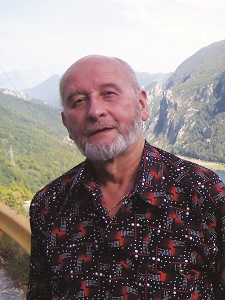
Anton Cetín
“Through my painting I strive to explain to myself the past, the present, and the future, actually the continuity of life”—these are the words of the great Croatian and Canadian artist, Anton Cetín, who to date has exhibited independently throughout the world, participated in a great many significant group exhibitions, with works found in many world museums and galleries, and whose name can be found in several Canadian, American, Croatian and international lexicons. A permanent exhibit of his work can be found on display in Čazma in a gallery bearing his name since 2001.
Cetín’s artistic output is vast and also awe-inspiring. Looking at individual series of his works chronologically and the output in its entirety, the placement of new ideas is fascinating, elaborated as variations of a theme. With the force of all possible artistic elements, the series give the impression of a stream of consciousness, a continuous flow of ideas fraught with dilemmas, questions, revelations, emotions and hope, unquestioningly preoccupied with the transcendental and yearning for the eternal.
The compositions with Eve and the bird, Anton Cetín’s recognizable motifs demonstrate an inexhaustible imagination and tremendous artistic power in portraying subjects in a novel way and always through new expressions, resulting in a host of themes and associations. Through the symbolism associated with her, Eve consistently directs towards life and, in various forms, to life’s abundance and diversity, to its fragile quality, its continuity and eternalness.
The series with wheat fields are especially noteworthy and can be viewed as interesting depictions of the Canadian landscape, but also as the development and exuberance of life and personal interaction. (Wheat Fields A8, 1981.)
I was greatly honoured and pleased when in January 2016, Anton Cetín sent a short e-mail agreeing to an interview. I am particularly grateful to Mr. Cetín for taking the time whilst preparing for five exhibitions planned for September 2016 in Croatia, as I learned at the end of our conversation. The exhibitions in question will be held in galleries and museums of the native Croatian areas closest to him—Čazma, Bjelovar, Kutina, Petrinja, and then Zagreb. Because of his sense of belonging and kinship with his native land, on the occasion of the artist’s 80th birthday, all the exhibited works will be gifted to the galleries and museums of the cities mentioned, as well as to the National University Library in Zagreb.
Jasna Lovrinčević: “Your works of art, their presentations and reception throughout the world are immense and admirable, as is your life’s path which took you from Bojana in your early childhood, through Zagreb to Paris, Toronto and through your works to the rest of the world. Could you tell us something about your beginnings in art, when did you actually start painting, or rather drawing? When was it that you recognized the painter or artist in yourself?”
Anton Cetín: “I started to draw quite early in my life, when I was five or six years old, and to paint a little later. When I reflect on what has transpired in my life between then and now, including my involvement with art, I become more convinced that there was a certain guiding force or protector standing behind certain events, perhaps one could even call it a higher force. Already quite early in my childhood I faced and lived through many horrors of the Second World War. But even in those times there were positive moments. All that, I believe, shaped not only my view of the world, but also my involvement in art. Because it was risky and dangerous during the time of war to leave the house, my curiosity and tireless star-gazing and contemplation about what was actually happening in that endlessly mysterious space or universe, was only possible to do at night, through the window.
By the end of the war in 1945, I was nine years old and I had an unbelievably wondrous dream in which I saw unusual architectural forms and even stranger flying objects which to me were unbelievable until then, and I heard a voice say such objects would be built in the near future not only on the earth but also beyond it, in space. From this dream later emerged the series of paintings Spaceships and Space Architecture.
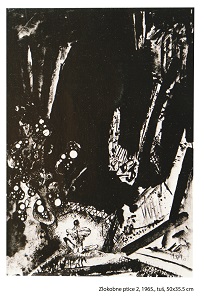
Anton Cetín: Ominous Birds 1965
The period from 1954-1964 I attended the School of Applied Arts followed by the Academy of Fine Arts in Zagreb. The professors at these two educational institutes, mostly well-known Croatian artists, guided us with their artistic experience and knowledge, in learning and perfecting the techniques of drawing and painting, and introduced us to the secrets of the art profession. After graduation, confident in our academic grounding, we set out courageously in pursuit of our artistic goals and dreams. The path, however, was not as smooth as we had imagined in that we did not expect the thornier side of the calling. In the end our creations will be the only indicators of our success.
At the beginning of the 1960s in the last century, the fear of the atomic bomb made the situation in the world extremely precarious and the ominous threats of apocalyptic proportions hung over our heads. We feared not only for our own survival, but also for the unpredictability of our future. As a reaction to all of that my drawings entitled Ominous Birds emerged in 1965.”
Paris – Genesis of Eve
Jasna Lovrinčević: “From 1966-1968 you lived in Paris and created a significant body of work, some 250 pieces. This represents an extraordinary burst of creativity. What was the main stimulus behind that intense drive? In 2008 at the Mimara Museum in Zagreb you exhibited 100 of your Paris works and you said that you “often looked at those works while in the intimate confines of my atelier as dear mementos, long-harboured in the heart…” What exactly do these works mean to you? Had you already been to Paris prior to that? I would like to ask you to say something more about that particular period which is said to be an important passage in the development of your art when you introduced Eve into your paintings.”
Anton Cetín: “My first trip abroad was in 1964 as part of an excursion with a group of Zagreb Academy students to Paris. My second trip to Paris, this time with the intention of staying, came about at the beginning of 1966. However, in order to be able to stay and live there one had to find work. It was impossible to live from one’s art, especially for those newly arrived and unknown. I brought with me ten selected illustrations from among one hundred that I made for the publication From the Pedestrian to the Rocket at the Mladost publishing house in Zagreb, and I showed these to Mr. Tamagno, director of the illustration section at Larousse in Paris.
Enthused with the quality of the illustrations, he kindly directed me to one of the five best-known illustrators in Paris and their immediate associate, J. M. Rabec, who immediately offered me a job. Along other design work, I also worked on illustrations for the Larousse publication Planètes & Satelites. With this I resolved the question of living and staying in France.
My two years in Paris were indeed intensive and productive. Besides working and learning the language, I devoted all my free time to art. Finding myself in a new, different and freer environment with a less tense international atmosphere, my art experienced a major transformation. Unexpectedly the sun, clarity and hope in a better tomorrow appeared in my new works and opened up new creative possibilities for me. In 1966-1967 my Phantoms emerged, successors of the Zagreb Ominous Birds, slowly freeing themselves from the burdens of the recent past, resolutely leading towards a more positive and brighter future.

Anton Cetín: Maternity
It was here that my Eve was born in 1967. From her very beginnings, through different civilizations and cultures in history, Eve was surrounded by mystery, transformations and adoration, which has not changed to this day despite our modern, what we like to call, enlightenment. She represents femininity, the giver of life, the spirit of peace and harmony, the icon of creative sanctity-in short, she is a spiritual being. In my works she often takes on a heart-like shape, and the heart is the centre of life, determination and prudence, intelligence and wisdom, a symbol of earthly and divine love, and as such Eve is an inspiration and the moving force which guides my creative energy towards the creation of what for me is a new world, a world of the vision of my art. I consider the oil on canvas painting, Maternity, to be one of the first works with the image of Eve, which continued to be present in countless variations later in Canada. My Paris works, sketches, drawings, gouaches, collages, paintings and lithographs, which I created in my nineteen months there, were indeed extensive. They were the result of a truly creative drive.”
The First Independent Exhibition
Jasna Lovrinčević: “You held an exhibition in Paris, which, I imagine, was not an easy thing to do. It would be interesting to learn about the circumstances that led to it.”
Anton Cetín: “On a beautiful spring day in 1967 as I was walking through Montparnasse I found myself in front of the Atelier Edouard Noël. I walked in and met the owner, the charming Mr. Noël. After introductions and a conversation, he offered me workspace in his atelier under very favourable conditions, which I could not turn down. Whenever I had free time I would go to the studio and already by autumn I completed several coloured lithographs which impressed him. To my great surprise not only did he offer me an exhibition, but also offered me to move to his castle outside of Paris with ample space to live and work, under his sponsorship. I accepted his offer of an exhibition, but because I had already made plans to leave Paris, I declined the other offers. Thus, at the beginning of February 1968 I had my very first one-man show of some of the works I had created in Paris at the Atelier Edouard Noël.
Even though with time the number of my Paris works in my possession had become smaller, due to a planned exhibit in Croatia I was still able to select 100 works which in my opinion, were the most characteristic of that period. The exhibit, entitled 100 Parisian Works was displayed in 2006, 2007 and 2008 and traveled to museums and galleries in eleven Croatian cities: Čazma, Kutina, Koprivnica, Križevci, Bjelovar, Vinkovci, Našice, Slatina, Virovitica, Zagreb, and Split.”
Canada – A Time of Intensive Creativity
Jasna Lovrinčević: “From Paris you moved to Canada. What impact did the new milieu in Toronto have on your artistic inspiration?”
Anton Cetín: “On arriving in Canada, specifically to Toronto, and becoming acquainted with new surroundings completely different from what I left behind in Paris, I endeavoured to devote all my free time to painting and print-making. New themes emerged through intensive and dedicated work, such as the series of paintings entitled Lovers, the series Search for the Beyond and Reflections on Infinity. In the series Lovers the embracing figures on the canvas represent not only a sense of freedom of motion in space, but also a belief in the capacity of the human mind to extend its limitless imagination beyond the confines of this Earth.

Anton Cetín: Reflection on Infinity II 1971
The series Search for the Beyond is essentially a continuation of the series Lovers—the concept was the same in the creative and technical sense, only now the lovers are joined by flying crafts—spaceships—by virtue of whose presence the boundaries of space are appreciably extended, giving the paintings a new dimension, opening up limitless possibilities of its further exploration. In the series Reflections on Infinity the use of a specific technical approach in resolving the paintings’ structure— especially on the surface of the paper—brought about complex, almost surrealistic planes and depths within a new and different space. Within that space are images of windows made with emphatic, sharp lines—closed, half-closed or completely opened—and inside the windows there are depictions of the Earth or some other planet, and in some instances the figure of Eve is included. The windows appear as portals suggesting some other place—another dimension—which together reveal not only the idea of infinity and its expansion in all directions, but also an attempt to present that reality as a rational organization of geometrical figures.”
Confidence in His Own Creativity
Jasna Lovrinčević: “Following Paris, after less than a year in Canada, you held an exhibition in 1969. This was followed by exhibitions in 1971, 1973, and already in 1974 you exhibited in Japan, Belgium then again in Canada followed by practically the rest of the world… This is a fascinating turn of events. Were you personally at all the openings? How difficult was it to organize so many exhibitions? I invite you to say more about this, because very few artists experience this.”
Anton Cetín: “Indeed, I started to exhibit my works after only one year of arriving to Canada. The exhibitions in Canada led to opportunities to exhibit abroad. With the help of people I met and worked with during my exhibits, it became increasingly easier to organize new shows. Since exhibitions often took place in more than one country at the same time, I was unable to be present at all the openings, but I made a point of personally attending the bigger and more important shows. Of course, this was only possible because of my persistence and dedication, an immense will and above all because of my belief in myself and in my art.”
Artistic Transformation
Jasna Lovrinčević: “You once spoke of a car accident in 1972 and how that made you realize, in a sense, the purpose of your life. Could you please tell us something about that? You also declared that after the accident you discovered a desire to fight against everything negative in the world. In what way did you do that? Today the negative is not accepted as negative and the good is not considered good; what do you actually see as good in this seemingly relative approach?”
Anton Cetín: “The car accident was an extremely critical experience. In an instant I found myself in a sort of tunnel filled with indescribable whiteness, and with dizzying speed all the moments of my life passed by in a few seconds. And then suddenly everything stopped, disappeared. I woke up a few hours later in a hospital with a doctor standing by my bedside telling me I was incredibly lucky to be alive. I felt I had been reborn and along with that I experienced a new, more positive understanding of the value of life and its spiritual side, all of which caused a great transformation in my art. After a recovery that lasted an entire year, I returned to a painting I had started before the accident and infused it with the change that I had experienced and when completed I called it Rebirth. The same happened with the painting Existence – Continuation. My declaration that I fight against everything negative with the positive emanates from the experience of that accident. I think the suggestion that today the negative is not perceived as negative and that the good is no longer accepted as good is a generalization I do not have an answer for.
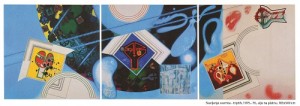
Anton Cetín: Celebration of the Universe 1975
The series Eve and the Moon from 1974-1975, consisting of several tens of drawings and collages, shows two figures from the mythology of love—Eve and the moon—in their long and complex history of iconography interwoven with Eve’s constant and unpredictable transformations. In these drawings and collages I attempted to gather the richness of imagery, colour and materials which could assist in the realization of new ideas in new series or particular themes. Thus from that series there emerged a large format painting, 183 x 549 cm, a triptych titled Celebration of the Universe, followed by other paintings, also in large format; the triptych Three Graces, the triptych Invitation, Eve in Red with her spiritual symbol, and many others.”
Landscapes Around Calgary
Jasna Lovrinčević: “The paintings in the Wheat Fields series from the1980s are presented in the form of endless lines in concentrated circles, but one field under the title Contoured Field II creates the impression of a labyrinth. Am I seeing it correctly? Do the wheat fields open up the question of preordination and freedom, because in the painting Wheat Field A8 from 1981 one gets the impression that the endless line is being drawn by someone from above?”
Anton Cetín: “The series Prairies came about after a flight to Calgary in 1980 that left a strong impression on me. From the airplane at some 10,000 metres, the sight of wheat fields, arable land, uncultivated surfaces and the lakes fascinated me and I could not resist recording this with some sketches in pencil and in photographs, sensing the start of a new series, a series of a vision from a completely different environment. It was truly impressive to view those immense surfaces from that vantage point, so reduced from that height yet with clearly defined forms, structures, and colours which they filled. The core idea behind the paintings in this series aims, in part, to artistically portray the structures that emerge from the cultivation of land as well as at the depiction of the impact of the experience in relation to space and perspective.
The lines moving in a concentric circle and in other patterns of the wheat fields are actually lines that the combines leave behind when harvesting the fields, which viewed from that height create the impression of a labyrinth. In less than two years, from 1980-1981, I created a good number of drawings, collages, paintings and prints. Periodically from 1981 onwards the theme resurfaces and remains alive. Thus, for example in 2015 when I created a new series of works titled Inspirations of the Fields, the image of Eve is visibly connected to them.
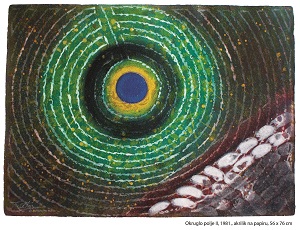
Anton Cetín: Contoured Field II 1981
The year 1981 was an exceptionally important and productive one for my work. For the first time a fully developed figure of Eve appeared in a profile followed by the series Eve and the Flower-bird; a combination of Eve, the bird and the flower. At the opening of my exhibition at the National and University Library in Zagreb in 1988 among other things, Tomislav Ladan said: “The mystical and vibrant trinity of woman-bird-flower embodies irrefutable traditional roots of the spirituality of the feminine combined with the cult of the life-bearing woman and the spirit symbolized by the bird, together with the flower representing love and nature itself.” From this interconnectedness emerged a large painting in 1983, Eve and the Flower-bird in Blue, followed by paintings of various sizes: Ecstasy, With Yellow Flower-bird, With Green Hair, Mystery, and others.”
Contemplation About the World Beyond
Jasna Lovrinčević: “You made a very interesting statement once saying that you feel you are living not only here on this earth but also in some other place and that is why your figures find themselves in a particular space or there is a window into some other dimension. The painting titled Motion in Space VIII (2000) or the diptych Eve, Then and Now (1993), the painting Play in Blue (1992), as well as the series of paintings called Rainbow (2012) with a blue-coloured background suggest a total immersion into blue space. Is the blue space in these paintings related to the space that you sense?”

Anton Cetín: Contemplation Upon the World Beyond III
Anton Cetín: “Given that we all live on this Earth and that daily we look into that limitless and mysterious space or universe and contemplate everything that is happening there, my personal thoughts on this are based on events from my childhood as well as later ones which I already mentioned, as an attempt to realize everything that I had experienced, including things of a transcendental nature. From this I came to the realization that, looking from earth, I am personally, and with that my art, a part of that universe and within it a part of some other space. It is because of this that I feel as if I am living also in that other place. From 1987 to 2000 a great number of works emerged: paintings, pastels, drawings, collages, prints in various techniques on themes tied to the ones from the 1970s on contemplations about infinity, the otherworldly and the unknown world, including Journey to the Unknown, Play in Blue, Eve, Then and Now, Eye into Infinity I, II, III, Rapture, Contemplation upon the World Beyond I, II, III, and others.”
Expression of Colours
Jasna Lovrinčević: “Looking at your works that were created in Canada with their pronounced colours which create a strong impression and generate an atmosphere which affects the viewer—in the monograph Anton Cetín Branka Hlevnjak states that “These colours, according to the artist, are chosen for a reason”—one immediately thinks of Goethe, Mondrian, Kandinsky, Rudolph Steiner… Once again the question about the choice of colours comes up: was this a conscious choice based on a familiarity with the theoretical texts of the mentioned authors, or is the selection a subconscious one guided by your artistic intuition?”
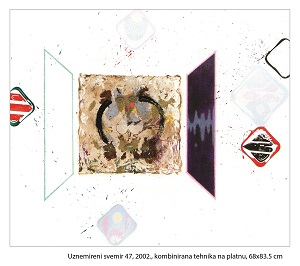
Anton Cetín: Universe 47 (2002)
Anton Cetín: “At the beginning of 2001 I started to work on a new series of paintings on canvas using mixed media that was yet to be titled, a series that already carried signs of the troubles of that time. On September 11, after the dreadful event of airplanes crashing into the Twin Towers of the World Trade Center in New York, and while the fire was still burning and the smoke still smoldering, I went to my studio with the intention of transferring some of that onto canvas. However, impacted by what I had seen and experienced and overwhelmed by emotion, I was unable to do anything. And then suddenly, to my surprise, the title Universe Disturbed appeared. Since I always considered myself to be an advocate of humanity and spirituality, I felt an irrepressible need to immerse myself in this extremely challenging series based on that horrifying event to draw attention to the inhumanity that surrounds us and to alert us to the increasingly aggressive intent to limit, if not destroy, our humanity and spirituality. In the works from this series the external objects, mainly of triangular shape, are directed at Eve who by retreating into her own world is trying to protect herself from those threats. The colours, particularly the combination of black, red and green within those extraneous objects, were chosen because they best convey their aggression. After close to three years of intensive work, the Universe Disturbed refused to be reconciled with my bringing it to an end, persistently wanting to return, because clearly the universe was still ‘disturbed’.

Anton Cetín: Revival III 2003
Immediately after the completion of paintings on that distressing theme, Universe Disturbed, in 2003 a new series emerged, titled Revival, which was described by Ivanka Reberski in a catalogue for an exhibition marking the tenth anniversary of the Gallery Anton Cetín in Čazma (2001-2011) as follows: “Once again light flooded into Cetín’s world. From the bright circle of the sun, which now prevails, flows a great source of energy. From this field of energy positive impulses unfold, while on the sensitive face of the faithful ‘Eve’ a feeling of infinite yearning and hope radiates, for without hope we would no longer be able to believe in a better world. This positive charge continues in the paintings called Revival I and Revival II from 2003. As though with a thin vertical line, Cetín divided the world in these paintings into the present and the past or the future, into good and evil, into light and darkness, with which he confronted us directly by depicting a shining circle of the sun on a dark blue background which can be associated with the night, the sea, the sky, the distance, the depth. Everything remains open to our powers of association and left to the free imagination. It is in precisely this that the uniqueness of Cetín’s artistic rhetoric rests.”
The Rainbow as a Sign of the Almighty
Jasna Lovrinčević: “From 2008 a new series of paintings appeared titled Rainbow. What do the colours of the rainbow, the rainbow itself, mean to you?”
Anton Cetín: “The series of paintings Rainbow came after observing that natural phenomenon and thinking about it as a spectacle of beauty in all its colours, which are also mentioned in the Bible. It is believed that the rainbow is a sign of the Almighty. It is also mentioned in the story about Noah when after the flood, God appears and in the sky a beautiful rainbow emerges signifying his glory and power.”
Jasna Lovrinčević: “The painting Rainbow 35 from 2012, without Eve, depicts a modified cone filled with the colours of a rainbow floating in infinity, but divided into three shades of blue, giving the impression of a culmination of a sequence of reflections or a spiritual quest that can be followed throughout your works, but also in the manner of your artistic exploration which too is traceable over time. Looking at this painting in its array of creativity, one hears almost a triumphant music, a grand finale (this is my personal experience) or perhaps indifference. Does this painting perhaps represent the end of artistic creativity in the absence of Eve, your “creative force”, does she represent the realization of longevity in art or is it a culmination of a certain realization? The Rainbow series from 2008 and 2009 remind me personally of Jakob Böhme and his Philosophical Sphere or Eye of Eternity. Can such a parallel be drawn? On the other hand, you said in a video recorded at the time of your Wheat Fields that through your paintings you are attempting to explain the past to yourself, the present and the future—the continuity of life. Can the series Rainbow also be understood in that context?”

Anton Cetín: Series Rainbow 35 ( 2012)
Anton Cetín: “In the series of paintings from 2008 and 2009, as well as in 2012, in addition to resolving the issues of harmony and balance of the colours of the rainbow with the image of Eve, we encounter not only certain artistic explorations but also the positioning of other elements in relation to her image in the context of the overall composition. There are contemplations and searches for the esthetic as well as for spiritual values. In order to achieve especially the latter quality, the blue colour is of special importance. As already mentioned, through my paintings I am trying to explain to myself the past, the present and the future; the continuity of life actually, and the series of these paintings can be understood in that context as well.
The thought that the series Rainbow remind you personally of Jakob Boehme’s Philosophical Sphere or Eye of Eternity through which he expresses his vision and understanding of the harmony of the universe and the gift of a specific calling from God is flattering. The very fact that we are dealing with a gap of four hundred years, the very thought of making such a connection with the name of Jakob Böhme could be interpreted as overly aspiring. I therefore leave it to you to draw the suggested parallel.
The series Rainbow without Eve is an attempt to create something new in my work—to create a visual sense of the sound of music. When I paint I almost always have music playing in the background, mostly classical music, and I see that as an important component of my creativity. That is why I think your suggestion that one can hear triumphant music, a grand finale, when viewing this painting is not only not surprising, but is also flattering, if I may say so, because it confirms what I intended to portray. Regarding the question of whether this painting represents perhaps the end of my artistic creativity, especially in the absence of Eve—my “creative force”—I would say that many other of my works also contain no image of Eve, but this does not mean, however, that she is not present in spirit.”
Jasna Lovrinčević: “The images or symbols that regularly appear in your paintings; the figure of Eve, the heart, the bird, the flower, the rainbow, are in a sense, recognizable features of your works. Did these symbols emerge intentionally, consciously, or as an inner need to express something that is not apparent from their conventional meaning, and which, as you say, every viewer of your painting creates his or her own interpretation?”
Anton Cetín: “Many of the images that I use, symbols actually (the image of Eve, the heart, the bird, the flower, the colours of the rainbow—the rainbow itself) came about intentionally, though admittedly there are also nuances that came about as a result of an inner need to convey something beyond what these symbols conventionally represent; and to be sure, as you say, every viewer of my paintings or paintings of other artists, creates his or her own interpretation in some world of their own.
In 1978 a Canadian art critic and historian, Gordon McLennan, stated the following in a review of my art for the journal artmagazine37: “For Cetín art civilizes and humanizes. The artist deals with spiritual truth. He creates because he has no alternative”.”
Translation from Croatian: PH.D Vladimir Bubrin
